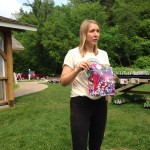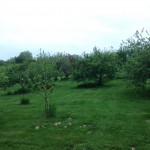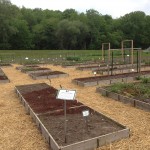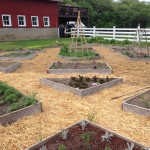Today had a good mix of topics and even a little learning on-the-go. We first met with Renae Zoske, an independent crop insurance agent who also happened to be the agent of Scott and Denny, who told how farmers and agents work through the complex world of insurance plans and regulations. To start, crop insurance, as with any insurance, is all about managing risk and preventing a farmer from losing all his income due to a natural disaster. Although getting crop insurance almost seems a given, it hasn’t always been that way. Congress first authorized an insurance program in the 1930s to recover from the Great Depression, but the program never caught on, receiving low participation even when subsidies were authorized in the 1980s for paying some of the premiums. Therefore, after every natural disaster that significantly affects farmers in a certain area, Congress would have to come up with an emergency relief plan. After drought in 1988 and floods in 1993, Congress decided that it had had enough and drafted the Agriculture Risk Protection Act that greatly boosted the subsidies given to farmers to reduce the amount they paid on premiums. According to Zoske, as of 2013, $4.5 billion is spent on crop insurance, and 90% of farmland is insured. However, the Obama administration is looking at cutting these subsidies. Insurance providers widely oppose the plan because it is assumed that farmers will drop plans if they decide the new premiums are too high. As with any insurance plan, providers need a wide participant base to spread out the cost of the risk, i.e. having the capital needed to provide compensation to those that lost crops due to natural disasters. Additionally, agents are afraid that the larger corporate farms, such as Summit, will pool their resources and begin their own insurance plan.
Although this topic was very technical and business heavy, it was much easier to understand than learning about bank plans earlier in the course. There are five main steps in getting crop insurance. 1) Know your cost. Your agent has to know the input costs and the potential yields to know who much to insure. 2) Pay attention to deadlines. There are several deadlines that farmers must follow when trying to insure their crops. This is unique from other insured materials because analyzing risk and responsibility depends on the planting season. For example, if you try to plant before the official start of the growing season (which is different by crop) you cannot qualify for replant coverage, which exists in case seeds do not germinate. Additionally, because farmers often change their crops and planting habits year to year, they need a new plan every year. 3) Know your APH. The Actual Production History is basically the life story of your farmland, and each farmer has his own number. It tells how good or bad the land’s yield have been and therefore used to calculate the guarantee and premium. New farmers do not have their own APH, so they must go by the county average. Luckily, in an effort to boost the number of the nation’s farmers, the new Farm Bill boosted the subsidies to these new farmers, or “new producers.” 4) Choose products. These are different plans that can be applied to different farms and across different counties. There are two main products: yield protection and revenue protection. The first pays according to the expected yield by number of bushels per acre. The second product has a higher premium, but the farmer collects if the spring price falls (set before the growing season by the Chicago Commodities Board and announced March 1) or if the fall price is higher after a loss. 5) Choose private products. Federally subsidized crop insurance only pays up to 85% of the crop. Therefore, you insure the other 15% by buying different disaster products, such as for hail, wind, drought, or rain. The most common threats in Iowa to the corn and soybean crops are wind and hail followed by rain and drought.
We then traveled for two hours to Decorah, IA to visit the Seed Savers Exchange, a non-profit that collects and preserves heritage seed varieties of vegetables, fruits, herbs, and flowers. It’s basically a smaller version of the Svalbard Global Seed Vault in Norway (link). People from across the U.S. will send their seeds to Seed Savers either just to increase the library or if they do not have any remaining family to whom they can pass down the seeds. I think it is a very neat idea and a good representation of the variety of foods that I didn’t even know existed. Toby, our guide, told us that we may only really see four to five different varieties of apples at the grocery store and maybe a few more at a farmer’s market. However, at Seed Savers, they grow, harvest, and collect 950 varieties of apples. I was also taken aback by the size of the farm. Since its beginning almost 40 years ago, the farm has grown from around 80 acres to 890, featuring over 30 gardens, an orchard, and fields for raising chickens and Ancient White Park cattle, one of only five herds in the world. To put it in perspective, Furman’s campus is 750 acres, including the woods and golf course.
- Toby showing us the seed savers catalog.
- The apple orchard has 950 varieties of heritage apples.
- Toby’s personal creation. There are four main sections, each containing herbs and produce from four different countries of the world: South Korea, German, Italy, and Mexico.
- Another seed harvesting garden.
After Seed Savers, we traveled to Iowa City to meet with state representatives the next day. Having been graced with a built-in DVD player, we were able to watch My Father’s Garden while on the road. This documentary tells the stories of two different farmers. One is the director’s own father, an orange grower, who jumped on the new developments in agricultural technology, specifically chemical fertilizers, pesticides, and herbicides. He died at 40 years old of an undiagnosed illness that affected most of his organs. It is implied that his heavy and arguably enthusiastic exposure to these chemicals contributed to his death. The second farmer is Fred Kirschenmann, a farmer in North Dakota. His story traces his efforts at turning his dying conventional farm into a large-scale organic one. The film tries to set a positive example for a turn towards large-scale organic farming and away from conventional, chemically driven conventional farms, whose input costs and tolls on the land are driving away small farmers from the lifestyle. One quote that struck a chord was by Fred, who said, “Every farmer must treat his farm as a garden.” This approach stresses a devotion to sustainable practices, including utilizing natural ecological process and maintaining soil health. I would say more, but we will actually meet Fred two days from now, so I will have to more to say then.




